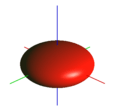Centrifugal force facts for kids
Centrifugal force (say: sen-TRIFF-yoo-gal) is a "fake" force that seems to push things away from the center when they are moving in a circle. It's called "fictitious" because it's not a real push or pull like gravity or friction. Instead, it's how things feel when you are inside something that is spinning or turning. Someone watching from outside would see something different.
Contents
What is Centrifugal Force?
Imagine you are in a car that is turning a corner. You feel like you are being pushed to the side, away from the turn. That feeling is the centrifugal force. It happens because your body wants to keep moving in a straight line, but the car is turning. So, your body tries to go straight while the car goes around the bend.
This "force" helps us understand why things move the way they do in a spinning world, even though it's not a real force.
Examples of Centrifugal Force in Action
Riding in a Turning Car
When you are a passenger in a car driving straight, you don't feel any extra pushes. But if the car turns left, you feel like you are being pulled to the right. This is the centrifugal force. Your body wants to keep going straight, but the car is turning. To stay in your seat, you have to push against the car (like with your hand on the door or your body against the seat).
From outside the car, someone watching would see that the car seat is actually pushing you towards the left, making you turn with the car. Without that push, you would just keep going straight! The feeling of being pushed outwards is just your body's inertia (its tendency to resist changes in motion). You might feel similar pushes on roller coasters or airplanes.
Swinging a Stone on a String
Imagine you are swinging a stone around on a string in a circle. The only real force pulling on the stone (besides gravity pulling it down) is the string pulling it towards your hand. This pull is called the centripetal force. It's a real force that keeps the stone moving in a circle.
If the string breaks, the stone doesn't fly outwards. Instead, it flies off in a straight line, exactly where it was going the moment the string broke. This shows that there wasn't a "centrifugal force" pushing it outwards. It was just the stone trying to continue in a straight line because of its inertia.
However, if you imagine you are tiny and riding on the stone, from your point of view, the stone isn't moving. But the string is still pulling you towards the center. To explain why you aren't moving, you would need to imagine a centrifugal force pushing you outwards, balancing the string's pull. This is why it's called a "fictitious" force – it helps explain things from a spinning point of view.
Earth's Rotation and Your Weight
The Earth is always spinning! It completes one full spin every 23 hours and 56 minutes. Because the Earth spins, things on its surface experience a small centrifugal effect.
Why You Weigh Less at the Equator
If you weigh yourself at the North Pole or South Pole, you'll get your normal weight. This is because at the poles, you are not moving in a circle due to Earth's spin. The spring scale measures how much Earth's gravity pulls you down.
But if you weigh yourself at the equator, you will weigh slightly less! This is because the equator is the widest part of the Earth, and you are spinning in a big circle there. The centrifugal effect tries to push you slightly away from the Earth's center. This tiny outward push makes you feel a little lighter. It's like a very small amount of your weight is being "lifted" by this effect.
The difference is small, about 0.3% less at the equator than at the poles. The Earth also bulges a bit at the equator, which also makes gravity slightly weaker there, adding to the weight difference.
How Centrifugal Force is Used
Even though it's a "fake" force, thinking about centrifugal force helps us understand how many machines work:
- Centrifugal governors are devices that control the speed of engines. They use spinning weights that move outwards as the engine speeds up, which then adjusts the engine's throttle.
- Centrifugal clutches are found in things like chain saws and go-karts. They let the engine run without moving the machine when it's idling. But as the engine speeds up, the clutch automatically connects, making the machine move.
- Artificial gravity in space stations could be created using centrifugal force. If a space station spins, the centrifugal effect would push astronauts to the outer walls, making them feel like they have weight.
- Spin casting and centrifugal casting are ways to make things. They use spinning molds to spread liquid metal or plastic evenly.
- Centrifuges are machines used in science and factories to separate different substances. For example, they can separate cream from milk or blood cells from plasma. When a test tube spins very fast, heavier parts are pushed to the outside, while lighter parts stay closer to the center. This is similar to how Archimedes' principle works with gravity, but here it's with centrifugal force.
- Some amusement rides use centrifugal force. For example, a Gravitron ride spins so fast that riders are pushed against the wall and can even be lifted off the floor!
All these systems can also be explained using real forces and motion, but sometimes it's easier to imagine the centrifugal force at work.
Images for kids
See also
 In Spanish: Fuerza centrífuga para niños
In Spanish: Fuerza centrífuga para niños





